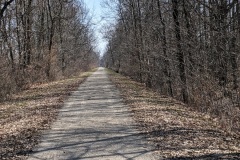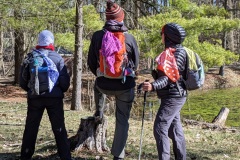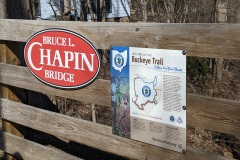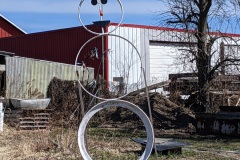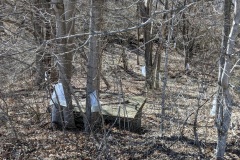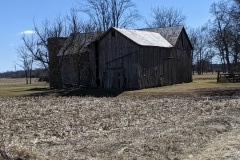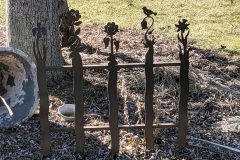Today is a new adventure for us!!! Because we have a lot of ‘rails-to-trails’ to cover in these sections we decided to try and bike it- weather was sunny and in the 50s- so almost perfect. Although it did take us a little longer to load/unload the bikes, we figured we would try about 11 miles and see how our bottoms held up. Not many walkers to worry about, which was good since our riding skills are rusty, and the terrain was VERY flat. Of additional interest, these sections of BT around Norwalk share the North Coast Inland Trails (NCIT), which runs along northern Ohio, and is clearly marked with signage along the way. The biking went by pretty fast (even though I’m slow, or as April put it, “the weak link” in the group) and before we knew it we were in the town of Norwalk, which was already known to April because of its fabric store with low prices and quality materials (luckily for me it was closed on Sundays). We had lunch in a little park and walked through the town, which was flanked on both sides by beautiful, historic old homes. This gave the impression that there was money at one time, not sure why, but it was still doing pretty well for itself by the looks of things. Very nice old theater and antiques store (couldn’t escape that one). It sure will be nice when COVID is over and we feel more comfortable going into places. A RR bridge after the town pointed out that the rail line we were biking went all the way to NYC- WOW! The rest of our trip was uneventful except that we almost ran over a baby snake crossing the path (I think it is a ‘brown’ snake- really, that’s its name). At the end, we decided our bottoms could have taken a little more riding if we had given them a rest, but we also decided that we DEFINITELY didn’t get enough time to talk very much! So maybe next bike outing we will ride a little further and take more ‘talking’ breaks.
Norwalk, sections 15-20 (3/14/21)
Well today started a lot faster since we had no parking issues at startup, planned to end at Collins Trailhead parking lot. Today started out on the road and finished up on a ‘rails to trails’ segment. We started right out with a VIGOROUS discussion about the challenges women face going pee on the trail or, more problematic, open road- which relegated me to a semi-interested bystander in the conversation. The talk centered on, how do I put this delicately, ‘engineering’ solutions and accessories to overcome these challenges that can be found on hiking websites, so we went over topics like zippered women’s pants that go from the front to the back…who knew? I don’t want to get into any more details here…do your own research. MOVING ON, the town of Wakeman was a nice little surprise of a town and seemed to have the bare essentials of a likable place- pizza joint, coffee shop, craft brewery establishment in a converted barn-like structure. Just before Wakeman there was also a very cool sculpture garden of iron works. After the town along a country road we saw some maple trees tapped to collect sap for maple syrup- seems its that time of year because we saw the same thing last week! More signs of spring are beginning to appear, like green grass sprouting up in the fields, snowdrop flowers in the woods, and the welcome sound of peepers from nearby marshes! On that note, as we were walking along a back road we were startled by a group (more than a dozen) of large grey birds which we now believe might have been migrating sand hill cranes. They were large, and they flew up from a low marshy spot, so we suspect they may have been feasting on all the peepers? That was definitely the highlight of the hike- too bad they were a good 100 yards off into the woods. Our day finished on the trail, which was a welcome relief to the bottoms of my feet.
So our new blog burner question is “were those really migrating sandhill cranes”? They certainly were grey, the size of herons and flew like them too (although they had to navigate up through the trees). Do herons and/or cranes travel in groups? Did not see any nests, so not a rookery.
Sherlock Answers: During migration, this species forms large flocks, which concentrate in vast numbers at certain areas during the journey, known as staging grounds. Small numbers of breeding sandhill cranes have been present in Ohio since 1985 and the number of nesting cranes has steadily increased over the last few years. They can be seen migrating through the state each fall to spend winter down south and then each spring to start nesting preparations.
Related Images:
Norwalk, sections 20-23 (3/6/21)
Back at it after an Ohio winter-induced delay to keep our fingers and toes from freezing off! Today’s feature image shows us proudly displaying our ‘Little Loop’ patches we received during the winter layoff! This put a little more spring in our step at the beginning of our hike (although sadly, or perhaps expectedly, this wore off after a few miles…). Once again was a minor chore to find a place to park the ‘finish’ car, but we did manage to find a skeptical but eventual willing farmer to share some parking space near his storage barn. After getting permission, April and I went and parked our car up the road a little ways at the barn and waited for Wendy to come pick us up for our drive back to the starting point to meet up with Robin…only Wendy never came? Turned out that Wendy had already headed back to meet Robin at the starting point without us! A phone call was needed to remind Wendy about our usual transport plan, which we have been doing for two years now… Wendy must have been extra antsy to get going (although you would never know it by how long it takes her to gear up for hiking). That may have been the highlight (or lowlight?) of the trip, besides hiking past a nice little log cabin on a pond that was almost perfect for my ‘On Golden Pond’ homesteading desires. Hike today was all road, but at least we avoided muddy trails from all the snow melt. Still a lot of Trump flags waving out here, just wonder if/when they will come down…maybe not until 2024? The long layoff from hiking had April and I dragging in the end, so the only remedy is to keep on at it!
We decided to add a new section: blog burner questions that arise from keen observations we make along our hike. Todays two questions are: 1) why are barns painted red? and 2) why did that farmer only grow his corn crop to half its size, with cobs still on the stalks, and leave it uncut over the winter? 3) How much do farmers make anyway? FEEL free to enlighten us in the comments section below! If not, we will rely on Robin as our newly appointed Sherlock Holmes stand-in to provide an answer.
Sherlock Answers: 1) New England settlers didn’t have enough money to paint their farms. So they needed a cheap way to protect the barns’ wood. They mixed skimmed milk, lime, and red iron oxide to make a red, plastic-like coating. The coating protected the wood and kept barns warmer in the winter. When paint became more available, many people chose red paint for their barns in honor of tradition.
2) The corn in the field is not necessarily dying, but drying. By drying out the liquid starch (milk stage), the corn can be harvested and used for all the necessities you and I need! From glue to corn flakes, cattle feed to fuel, corn (the dented field corn) is not only a complement to our society, but also a crucial source to create so many things. Without corn, a nation would simply not be born!
3) The lower 10 percent of farm professionals make less than $35,020, and the top 10 percent receive earnings of more than $126,070. The average farmer salary varies depending on how well the crops do and changes in operational costs for farmers.
50% of the 1600 farmers and ranchers polled said that they typically worked between 10 and 14 hours daily. Nearly 20% said that they worked about 15 hours a day.
If you love farming, it’s worth it, but it’s not a get rich quick scheme. Farmers don’t make millions, although they do average around $70,000 a year. The other problem with farming is that it’s hard to get started. Until you pay off your investment, you don’t get to keep much of that income.
Using projected average yields of 198 bu. corn and 59 bu. soybeans per acre, farms averaged $673 total revenue per acre and averaged $664 total cost per acre. The most profitable farm made $275 per acre while the least profitable lost $222 per acre.


